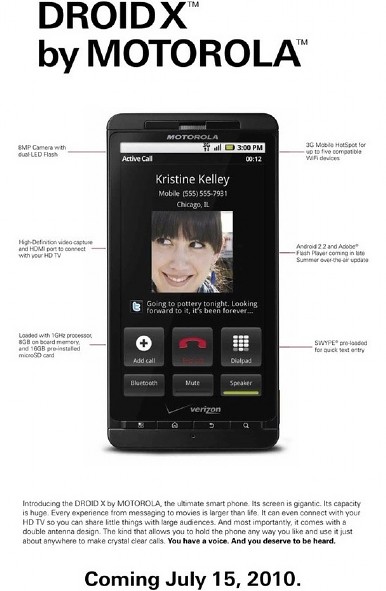With Apple still attempting to recover from the public relations fiasco resulting from antenna issues on the new iPhone 4, Verizon decided to have a little bit of fun at Apple’s expense in the form of a new full page ad for the upcoming Droid X which first appeared in the New York Times.
One of the device’s touted features includes the following description:
And most importantly, it comes with a double antenna design. The kind that allows you to hold the phone any way you like and use it just about anywhere to make crystal clear calls. You have a voice. And you deserve to be heard.
Well played, Verizon. Well played.

via Macworld





July 8th, 2010 at 10:14 am
Verizon and Motorola are treading on dangerous ground here. The attenuation of reception when a cell phone’s antenna(s) are in close proximity to or touching human skin is a universal problem that is mandated by physics. You can get around it only by insulating the antenna with an insulator, such as air, which does not block reception.
So has the Droid X repealed the laws of physics? I doubt it. So does the Droid X increase the amount of air between the user’s hands and the its antennas? It doesn’t look to me like the Droid X is big enough to create that kind of space; it would, in fact, have to be too large to be marketable to do that. Has Motorola come up with some new non-conductive insulator that is a big improvement over electrical tape. Again, I doubt it.
So the Droid X is likely to be subject to the same problem of attenuated reception in the presence of human skin. What the Droid X probably has done to mask that problem are two things: (1) It probably calculates and represents signal strength more conservatively, showing fewer bars for a given level of signal strength. This will masks the drop in reception, and is probably what Apple intends to do when it issues the update for iOS 4. The second thing doesn’t have anything to with the Droid X. It is Verizon’s network. Quite simply, Verizon’s network provides better service in some of the bigger markets. This, in large measure, is true because Verizon’s network does not have to support the huge bandwidth demand of Apple’s iOS devices (iPhone and iPad). Be that as it may. That Verizon’s network provides a stronger signal will mean fewer failed connections for the Droid X, even if its problem with degraded reception is worse than the iPhone 4’s degraded reception when in close proximity to human skin.
However, notwithstanding Verizon’s better signal and a more conservative representation of that signal strength, it will, I think, be possible to show that for any given signal strength, the Droid X also suffers significantly attenuated reception, when a human hand covers the area(s) where its antennas are located. It just may be difficult for amateurs to see the effect, which again is what I think that Apple will be going for when it updates iOS 4 to more conservatively represent signal strength, but there is not much that Apple can do to correct for AT&T, where AT&T’s service is poor.